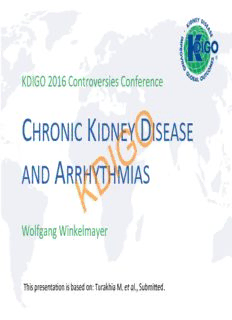
chronic kidney disease and arrhythmias PDF
Preview chronic kidney disease and arrhythmias
KDIGO 2016 Controversies Conference O C K D HRONIC IDNEY ISEASE G I D A AND RRHYTHMIAS K Wolfgang Winkelmayer This presentaBon is based on: Turakhia M. et al., SubmiKed. D ISCLOSURES • Salary supported from federal grants (NIDDK, NHLBI, NIAMS, AHRQ) and clinical acBviBes. • Advisory Boards/Consultancies (past 3 years: ACUMEN, Akebia, O AMAG, Amgen, Astra-Zeneca, Bayer, Daichii Sankyo, Fibrogen, G Relypsa, Vifor FMC Renal Pharma) I D • Data Safety Monitoring Board (Medtronic, Zoll) K • Co-Editor, AJKD • Associate Editor, JAMA • Member, Public Policy Board, American Society of Nephrology • Co-Chair, Kidney Disease: Improving Global Outcomes, KDIGO® Kidney Disease: Improving Global Outcomes P 1: ART O I NTRODUCTION G I D K Kidney Disease: Improving Global Outcomes CKD H R D AND EART HYTHM ISORDERS • PaBents with CKD are predisposed to atrial fibrillaBon/fluKer, supraventricular tachycardias, ventricular arrhythmias, and O sudden cardiac death (SCD). G • Treatment opBons are complex and limited in CKD. I D • PaBents with CKD are historically underrepresented in clinical K trials of treatment for heart rhythm disorders. • Considerable gaps exist in the evidence base for treaBng paBents with CKD and heart rhythm disorders. Kidney Disease: Improving Global Outcomes KDIGO C C ONTROVERSIES ONFERENCE • CKD and Arrhythmias—October 27–30, 2016 in Berlin, Germany. O • InternaBonal, mulBdisciplinary conference, divided into five G breakout groups: I D – Epidemiology of Atrial FibrillaBon and Stroke in Kidney Disease K – Stroke PrevenBon in Atrial FibrillaBon and CKD – Rate vs. Rhythm Control in Atrial FibrillaBon in CKD – Risk PredicBon and PrevenBon of SCD in CKD – Potassium Homeostasis and Handling in CKD and Dialysis Kidney Disease: Improving Global Outcomes C G ONFERENCE OALS • Assess the current state of knowledge related to the evaluaBon, management, and treatment of arrhythmias O and CKD. G • IdenBfy controversial topics and knowledge gaps. I D • Propose a research agenda to resolve these issues. K • Determine whether there is sufficient evidence to develop a clinical pracBce guideline • Help pave the way to harmonize cross-talk between the heart and the kidney communiBes. Kidney Disease: Improving Global Outcomes P 2: ART O A F (AF) TRIAL IBRILLATION AND G I S CKD TROKE IN D K Kidney Disease: Improving Global Outcomes A F TRIAL IBRILLATION • Most common arrhythmia – AffecBng ~2.7-6.1 million Americans in 2010 O – May increase to 12.1 million by 2030 G – Worldwide prevalence, ~33.5 million in 2010 I D – Age-adjusted incidence of AF increased by 12% from 1980-2000 K (Olmstead County, MN) – LifeBme AF risks are (Framingham Heart Study) • 23% for women and 26% for men at age 40 Kidney Disease: Improving Global Outcomes A F S TRIAL IBRILLATION AND TROKE AF increases risk of ischemic stroke 4- to 5-fold – Paroxysmal, persistent, and permanent AF all predispose to O subsequent ischemic stroke G – Diagnosed AF responsible for at least 15% to 20% of all ischemic I strokes D – Subclinical AF increasKes subsequent risk of stroke or peripheral embolism 2.5-fold – Subclinical (undiagnosed) AF may be responsible for another 13% of ischemic strokes Healey JS, et al. NEJM 2012;366:120 Kidney Disease: Improving Global Outcomes A F O O TRIAL IBRILLATION AND THER UTCOMES • While stroke is the most “recognizable” outcome of AF, analysis of the RE-LY trial showed that: O – 7% of deaths from stroke, but G – 22% were from sudden cardiac death I D – 15% from heart failure K – 36% non-cardiovascular death Marijon E, et al. Circula2on 2015;128:2192 Kidney Disease: Improving Global Outcomes
Description: